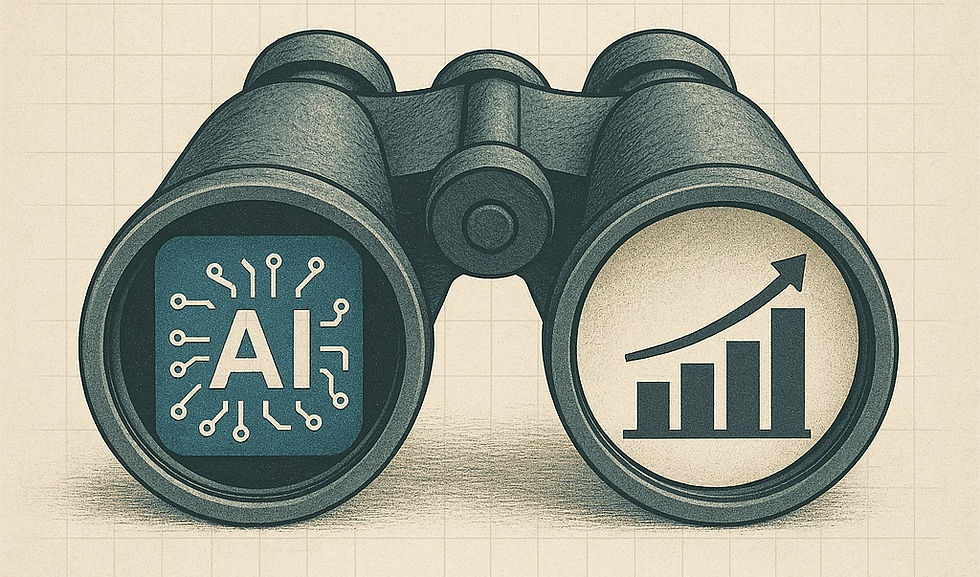Business Intelligence – the next step – Part 2
- Catherine Louropoulou
- Jun 9, 2022
- 3 min read
Updated: Oct 14, 2022

In this second part of our overview of reporting - or rather business intelligence - in today's business world, we will shed light on some of the less frequently discussed aspects of this subject. However, new business needs are demanding - even if the business community is not fully aware yet - new and advanced solutions that traditional tools cannot provide.

In Part 1 (see here) we discussed that the information capacity of the basic ERP and CRM systems is quite limited or at least focused on traditional questions posed within the day-to-day operations of the business. But to answer other more complex questions, basic reporting is not enough. Likewise, one of the Business Intelligence tools developed in previous decades and since then are constantly evolved or improved is not enough as it seems.
Here are some new questions or "desires" of the present-day manager:
I want to be able to make predictions about the future, based on the historical data I have.
I want to be able to complement the databases I have with other data that I will find elsewhere (i.e. not from internal business systems)
I want to be able to take advantage of new technologies such as artificial intelligence and machine learning, with practical application on my own data.
In our view and E-ON INTEGRATION's experience, these and similar issues can be answered if the appropriate infrastructure is implemented "behind" the B.I tool of our choice. To explain it better, let us say that in many cases the B.I. tool sits "directly on top" of the business data of the ERP or CRM. This gives a lot of possibilities, but they are limited a) by this data and only this data and b) by the processing capability of the B.I. tool.
What does E-ON INTEGRATION see?
In this respect, we see the implementation of infrastructures which, depending on the needs, can be of the type of big data or data lakes or data warehouses and then the implementation of the B.I. of our choice on top of these infrastructures. The figure below gives a visual overview of this proposal.

Let us explain it better:
We anticipate the necessity to use big data infrastructure (and perhaps even in the cloud) in order to have the ability to store and process large volumes or high-speed data. The kind that traditional in-house infrastructure cannot "handle" or simply requires a lot of maintenance by in-house engineers.
There is a need to combine internal and external data of various " types " , such as custom EXCEL sheets, reports we receive from third parties, public databases with economic, climatic, demographic data and many others (all these cannot be stored in an editable format neither on a file server nor on our ERP business database)
It must be possible to combine all heterogeneous data in order to be able to view "our" data from other perspectives. Imagine, for example, an analysis of your sales by the financial capacity of your country's residents. Where are the most financially well-off of your customers located? Such kind of structured information could be organized from the "chaos" of a data lake in an orderly data warehouse. .
Experienced data scientists should have at their disposal the environment that will enable them to apply Machine Learning or Artificial Intelligence techniques to be able to give you new perspectives on your data ("insights"). Such technological capabilities are currently provided by large manufacturers on top of the infrastructure that you have "previously" taken care of implementing as a data warehouse. If you attempt to do it in-house, then you will have several major "technical" headaches and of course a significant to prohibitive cost.
E-ON INTEGRATION can help you in all phases of this "journey". We possess:
Experience in designing integrated solutions (and not just acting as a B.I. tool vendor),
Alternatives that complement the technology stack you already have,
After implementing the infrastructure, we can deploy a team of data scientists that will help you access insights that your data may reveal by using machine learning, natural language processing and general data analytics,
A team of programmers who will eventually automate the editing process and give you the final deliverable not in the form of a report of findings but an automated decision support system. And, to the extent necessary, "integrate" it with your existing business systems.
See more here and embark on a journey to exploit the wealth you already have: your data.




Comments